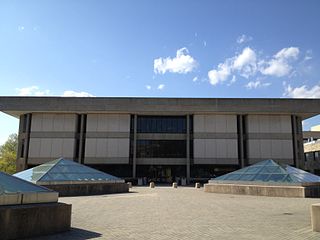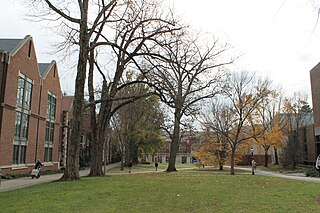
Liberal arts education is the traditional academic course in Western higher education. Liberal arts takes the term art in the sense of a learned skill rather than specifically the fine arts. Liberal arts education can refer to studies in a liberal arts degree course or to a university education more generally. Such a course of study contrasts with those that are principally vocational, professional, or technical, as well as religiously-based courses.
A Bachelor of Applied Science is an undergraduate academic degree of applied sciences.
The Master of Architecture is a professional degree in architecture qualifying the graduate to move through the various stages of professional accreditation that result in receiving a license.

The College of Architecture, Art, and Planning (AAP) at Cornell University is one of the world's most highly regarded and prestigious schools of architecture and has the only department in the Ivy League that offers the Bachelor of Architecture degree. According to DesignIntelligence, Cornell architecture students are the most desired recent graduates by architecture firms, especially in New York City. The department has one of the largest endowments of any architecture program, including a $20 million endowment by Cayuga County resident Ruth Price Thomas in 2002. The Master of Regional Planning (M.R.P.) professional degree program at AAP has been consistently ranked in the top 10 in the nation, according to Planetizen's Guide to Graduate Urban Planning Programs.
A Bachelor of Architecture (BArch) is a bachelor's degree designed to satisfy the academic requirement of practising architecture around the world.
Zaytuna College /zaj.tuːna/ is a private liberal arts college in Berkeley, California. It is the first accredited Muslim undergraduate college in the United States. It was built on the foundation of an educational institute, founded in 1996 by Hamza Yusuf and Hesham Alalusi. After graduating its pilot batch of full-time students, Zaytuna Institute formally changed its name to Zaytuna College in 2009.

The Yale School of Architecture (YSoA) is one of the constituent professional schools of Yale University, and is generally considered to be one of the best architecture schools in the United States. The School awards the degrees of Master of Architecture I (M.Arch I), Master of Architecture II (M.Arch II), Master of Environmental Design (M.E.D), and Ph.D in architectural history and criticism. The School also offers joint degrees with the Yale School of Management and Yale School of the Environment, as well as a course of study for undergraduates in Yale College leading to a Bachelor of Arts. Since its founding as a department in 1916, the School has produced some of the world's leading architects, including Norman Foster, Richard Rogers, Maya Lin and Eero Saarinen, among others. The current dean of the School is Deborah Berke.
Oppositions was an architectural journal produced by the Institute for Architecture and Urban Studies from 1973 to 1984. Many of its articles contributed to advancing architectural theory and many of its contributors became distinguished practitioners in the field of architecture. Twenty-six issues were produced during its eleven years of existence.

A public policy school is typically a university program that teaches students policy analysis, program evaluation, policy studies, public policy, political economy, urban planning, public administration, international relations, security studies, nonprofit studies-nonprofit management, political science, urban studies, intelligence studies, global studies, emergency management, public affairs and/or public management. Public policy schools typically train students in two streams. The more practical stream treats the master's degree as a terminal degree, which trains students to work as policy analysts or practitioners in governments, government relations, think tanks, and consulting firms. A more theoretical stream aims to train students who are aiming to go on to complete doctoral studies, with the goal of becoming professors of public policy, political science in general, or researchers.

The University of Cincinnati College of Design, Architecture, Art, and Planning, commonly referred to as DAAP, is a college of the University of Cincinnati. Located in the university's main campus in Cincinnati, Ohio, DAAP is consistently ranked as one of the most prestigious design schools in the U.S. and the world. The University of Cincinnati was also the only public school listed in I.D. Magazine's list of the top ten design schools worldwide.

NewSchool of Architecture & Design is a private for-profit college in San Diego that focuses on architecture and design. It is accredited by the WASC Senior College and University Commission (WSCUC).

The Association of Independent Colleges of Art and Design (AICAD) is a non-profit consortium of 36 art and design schools in the United States and Canada. All AICAD member institutions have a curriculum with full liberal arts and sciences requirements complementing studio work, and all are accredited to grant Bachelor of Fine Arts and/or Master of Fine Arts degrees. To qualify for AICAD membership an art school must be: a free-standing college specializing in art or design; a non-profit institution; grant BFA and/or MFA degrees; and have accreditation from both the National Association of Schools of Art and Design (NASAD) and the relevant academic accrediting organization in their region.

The New Hampshire Institute of Art (NHIA) was a private art school in Manchester, New Hampshire. It was accredited by the National Association of Schools of Art and Design (NASAD) and the New England Association of Schools and Colleges (NEASC) and was a member of the Association of Independent Colleges of Art and Design (AICAD). NHIA offered the Bachelor of Fine Arts as well as Master of Fine Arts and Master of Arts in Teaching. In 2019, the institute merged with New England College and is now the college's Manchester campus.

The Tulane School of Architecture is the school of architecture at Tulane University in New Orleans, Louisiana. The school has a student body of approximately 442 students.

Antioch University Los Angeles (AULA) is a campus of Antioch University in Culver City, California.
Urban planning education is a practice of teaching and learning urban theory, studies, and professional practices. The interaction between public officials, professional planners and the public involves a continuous education on planning process. Community members often serve on a city planning commission, council or board. As a result, education outreach is effectively an ongoing cycle. Formal education is offered as an academic degree in urban, city, rural, and/or regional planning, and more often awarded as a master’s degree specifically accredited by an urban planning association in addition to the university’s university-wide primary accreditation, although some universities offer bachelor's degrees and doctoral degrees also accredited in the same fashion; although most bachelor’s degrees in urban planning do not have the secondary-layer of urban planning association accreditation required for most positions, relying solely on the university’s primary accreditation as a legitimate institution of higher education. At some universities, urban studies, also known as pre-urban planning, is the paraprofessional version of urban and regional planning education, mostly taken as a bachelor’s degree prior to taking up post-graduate education in urban planning or as a master’s or graduate certificate program for public administration professionals to get an understanding of public policy implications created by urban planning decisions or techniques.

The College of Architecture, Arts, and Design formerly the College of Architecture and Urban Studies at Virginia Tech consists of four schools, including the School of Architecture, which consistently ranks among the best in the country. Headquartered in Blacksburg, Virginia, the college also has sites in Alexandria, Virginia, and Riva San Vitale, Switzerland. Spread out among these three locations, the college consists of nearly 2,200 students, making it one of the largest schools of architecture in the nation.
The College of Liberal Arts and Human Sciences at Virginia Tech comprises two schools, 12 departments, and three ROTC programs. The college also has connections to research facilities and local community service organizations through which students can earn experience in major related fields and has many study abroad programs. In 2010–11, the college had 4,386 students taking courses on the Blacksburg campus. The college's dean, Rosemary Blieszner, was appointed in 2017.
Mario I. Gandelsonas is an Argentine-American architect and theorist whose specializations include urbanism and semiotics.

Princeton University School of Architecture is the name of the school of architecture at Princeton University. Founded in 1919, the School is a center for teaching and research in architectural design, history, and theory. The School offers an undergraduate concentration and advanced degrees at the master's and doctoral levels.












